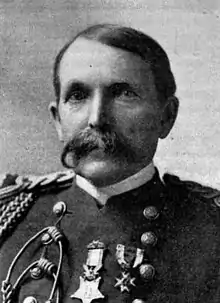John Curtis Gilmore | |
|---|---|
 Medal of Honor winner John Curtis Gilmore | |
| Born | April 18, 1837 Canada |
| Died | December 22, 1922 |
| Buried | Arlington National Cemetery, Virginia |
| Allegiance | |
| Service/ | |
| Years of service | 1861 - 1863, 1865 - 1901 |
| Rank | Brigadier general |
| Unit | |
| Battles/wars | Second Battle of Fredericksburg American Civil War |
| Awards | |
John Curtis Gilmore (April 18, 1837 – December 22, 1922) was an American soldier who fought in the American Civil War. He received his country's highest award for bravery during combat, the Medal of Honor.[1]
Gilmore's medal was won for capturing the flag and rallying the spirits of the troops under his command during the Second Battle of Fredericksburg on May 3, 1863.[1] He was honored with the award on October 10, 1892.[2]
Biography
Gilmore was born in Canada and was commissioned as a Captain in May 1861. He was promoted to major in September 1862 and mustered out in 1863. He rejoined the Army in 1865 and rose to the rank of brigadier general before retiring on his 64th birthday in 1901.[3]
He was a companion of the District of Columbia Commandery of the Military Order of the Loyal Legion of the United States.
Death and interment
Following his death on December 22, 1922, he was buried at the Arlington National Cemetery.[1][2]
Medal of Honor citation
The President of the United States of America, in the name of Congress, takes pleasure in presenting the Medal of Honor to Major John Curtis Gilmore, United States Army, for extraordinary heroism on 3 May 1863, while serving with 16th New York Infantry, in action at Salem Heights, Fredericksburg, Virginia. Major Gilmore seized the colors of his regiment and gallantly rallied his men under a very severe fire.[1]
See also
References
- 1 2 3 4 "John Curtis Gilmore". Archived from the original on June 29, 2014. Retrieved June 27, 2014.
- 1 2 "Civil War (G-L) Medal of Honor Recipients". Retrieved June 27, 2014.
- ↑ Historical Register and Dictionary of the US Army